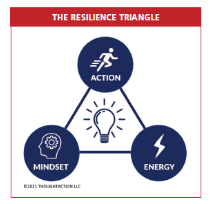Bouncing Forward to a New Normal – Part 2
 Last time we began exploring a model offered to us that holds the potential for jumpstarting our sense of resilience.
Last time we began exploring a model offered to us that holds the potential for jumpstarting our sense of resilience.
The Resilience Triangle comprises Mindset + Energy + Action. It’s like a three-legged stool. Lacking even one leg, the whole stool won’t stand firm. In part one, we were reminded of the power of our mindset, our perceptions, beliefs, expectations, assumptions – what we see as possibilities and what limits we may place on ourselves. I offered, metaphorically, our mindset is our windshield. It’s our view of our world and direction. It starts the motor for action and energy. So, let’s explore another leg, Energy.
The last two years were historic, rapid, and unexpected change. One day we were working normally and the next, we were told to go home for an undetermined time. Wow! We thought, oh, like a snow day or spring break – oh, no, nothing could prepare us for the next two years.

That type of change brought so much stress, so much uncertainty, our brains were like a mobile hanging in a windstorm. Day by day drained our energy tanks. Yet, energy is the very thing this needed to be active in thinking creatively, addressing challenges, and moving in a new direction. For months, educators did just that, they jumped into to meet the challenges. But the challenges kept changing, the demands more. How could anyone charge the battery when the energy demand is so high?
As it appears the future may be safe again, the calm may come after the storm, let’s explore our Core Needs to restore and charge our battery again. Core Needs are the 8-20 types of experiences that engage, satisfy, and fulfill us in our work and personal life. These experiences include achievement, connection, teamwork, accomplishment, learning, doing important work, being part of something bigger.
Each of us has our own unique combination of these and must have experiences from time to time to give us energy. Think of them as our personal fuel tank that brings us the power to do, to create, to plan, to dream.
To build back our energy, our “oomph” or “roar” to be resilient, we must recognize our personal set of core needs. Conversations that you know so well reconnect our educators to when they celebrated what they had done. What made that so exhilarating for you?
Remembering a day or week and what made the time so fulfilling. What aspects of what we do as educators bring you the most satisfaction? What is important to you about how you and your colleagues work together? What one thing would you change for the better about your job? Why?
Once we can assess the energy that motivates, engages, excites, and fulfills us, our fuel tanks begin to fill. Resilience requires change. Change takes energy.
Woo-hoo! My engine is roaring. Next time – the third leg, ACTION.
Ref: Choice (vol. 19, No.4) Practical Resilience by Jonathan Bates, PCC, MSOD
